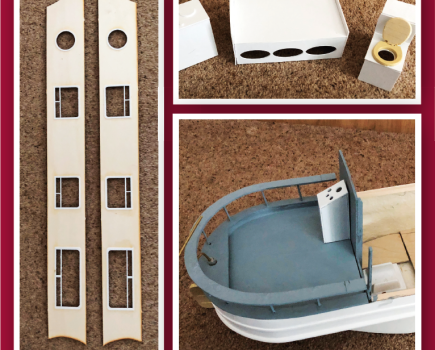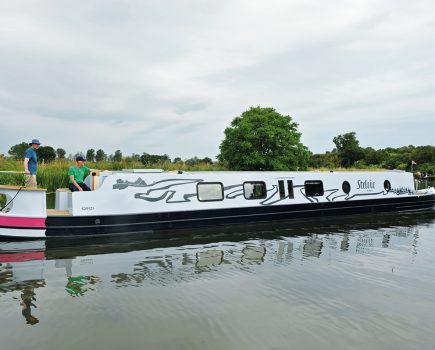Miscellaneous
MISCELLANEOUS
WEIGHTY QUESTION
Q: This isn’t a technical problem; I’m just at a loss as I need to calculate the weight of my boat for haulage and have no idea. It is 41ft long, 6ft 10in wide and has a draught of 3ft so fairly standard. Is there a way of working out a really rough weight guesstimate?A: Often weight is estimated as 1 ton or 1 tonne per metre of length. I think that tends to overstate the weight of a modern cruising boat, but as you state a 3ft draught, rather than the more usual 2 to 2.5ft it might be near enough.Whoever you employ to lift your boat should have lifted them before and they should have a fair idea from previous lifts and the scales on their lifting equipment. I would also advise that you use a transport company familiar with moving narrowboats – they again will have a fair idea of the weight – in any case I suspect the length of the boat will require a truck rated at several times the weight of your boat.If you want to be more exact with a weight calculation, measure the draught midway along the boat and the length of the front and back swims (all in metres). Subtract the lengths of the swims from the boat length and multiply your answer by the draught and beam to give cu. metres. Add the lengths of the two swims and halve the result. Multiply this answer by the draught and beam to give cu. metres. Add both answers together and as 1 cu. m of water weighs about 1ton/tonne you have the rough weight of the boat in tons/tonnes.
HOW DEEP IS YOUR LOCK?
Q: Which is the deepest lock on the entire waterways system? A: Excluding tidal locks (it’s impossible to say how deep they are since it varies with the tide) the lock on the Rochdale canal at Sowerby Bridge, built in the 1990s to replace locks 3 and 4, holds the record with a whopping 19ft 8 1⁄2 in rise according to Nicholsons guides. Close behind is the 19ft 5in Bath Deep Lock on the Kennet & Avon canal which replaced the original locks 8 and 9. For a list of all the deepest locks in England see Martin Clark’s website www.penninewaterways.co.uk
TANK CONTAMINATION
Q: The fresh water on my narrowboat has suddenly taken on the taste of TCP which is quite unpleasant. The feed to the toilet system is above the tanks and I cannot see any problem with back siphoning as the toilet is left empty. Is this due to a rogue water supply or a problem with my tank?A: I would need more information on the tank material and location/filling/inspection method to give a complete answer.If the tank is part of the hull and has an inspection hatch in the well deck floor I would be considering the integrity of the seal, especially if anyone has spilt liquid or done painting there recently. If the inspection hatch is a lift-up lid on the foredeck it could be deliberate contamination or is it possible that someone else has had a go at sterilising the system with TCP?In both cases emptying the tank and refilling with fresh water a few times should solve the problem.Your toilet supply should be equipped with vacuum breakers so a siphon should not be capable of building up – even so you would have to fill the bowl to rinse water hole height before there was any chance of back leaking. I think you can probably discount this one.If your filling hose is stored in such a way that water is left in the coils AND it was not allowed it to flush through before filling the tank, some plasticisers may have leeched into water that was left in the hose, especially if the hose not been used for a number of weeks.I find that water at more rural locations often seems to have a higher chlorine concentration than in towns so it could be the water supply. In fact I suspect it probably is. I think a trip to a water point well away from your local supply and a system flush may be in order.
GREASE IS THE WORD
Q: I read your article on maintaining steering gear and found it very helpful. Can you advise please the recommended specification of grease to use. At the moment I have to apply the grease with a gun through the nipple.A: Where is this nipple? I assume that it is used to lubricate the rudder stock from inside so I would use a ‘waterproof’ grease that is normally sold for sternglands – available from chandlers. However as long as you avoid genuine graphite grease, almost any grease soft enough to go through the gun will do because it is fundamentally a total loss system. Graphite is a bit high up the galvanic series so may cause corrosion if in contact with metal and water, especially salt water.If this is not the rudder stock and is thus well away from the water I would tend to use a moly-grease (horrid black stuff) because molybdenum will act as a lubricant long after the grease has dried out.
WASTE NOT…
Q: I am having a narrowboat built which we intend to take to Europe and I don’t know what type of toilet to choose. I can’t bring myself to consider pumping out toilet waste into the canal or river as I understand they do in France – and with a pump-out fitted, could I anyway? As for Germany: who knows what the rules are? Just what is the availability of pump-out on the continent? Are there universal standard fitments? If so how common or available are they? Is there such a thing as self pump-out? Is a cassette the better option? A: There are regulations relating to waste disposal on boats but pump out points are extremely rare in France and Germany, although they are gradually being introduced. Private and hire craft normally discharge directly overboard without use of potentially harmful chemicals. If having a new boat built for use on European waterways as well as in the UK, I would advise having a holding tank installed to comply with UK conditions but with a two-way valve permitting direct discharge overboard where there are no pump-out facilities available in France or Germany.Obviously it would be wrong to pump out the contents of a holding tank into the waterway so the direct discharge procedure should be employed each time the loo is used. I don’t advise use of a cassette loo system as approved emptying facilities are as difficult to locate as pump-out points. A further option might be one of the new ‘composting’ toilets.
DESIGNS ON PAINTING
Q: We recently bought a little tug with a solid front bulkhead and cut some doors in it which we’ve now lined to match the rear doors (blocks and inset centre panel). The existing doors are painted with ‘scrolls’ in the centre panels and a sort of compass design in the top block. We wanted to do the same on the front doors but also do a sort of ‘star’ style design on the bottom block to tie in with the boat’s name. You’re something of a historian on waterway painting — are there any ‘rules’ about what should and shouldn’t be done or is it just a question of taste and personal opinion? (After all, we’re not restoring a historic boat but a tug does have a certain traditional air about it which we wouldn’t want to spoil).A: There honestly aren’t any rules. It would only matter if you were restoring an historic boat or using the results for education or something. Modern enthusiasts often turn what could be called ‘tradition’ into a set of commandments – ‘Every castle must have a bridge , birds etc etc’ but it’s largely nonsense. It’s your boat so decorate it as you please.
HATCHING A PLAN
Q: We are fitting-out a new sailaway and are thinking of installing a Houdini hatch to help with light and ventilation. Could you offer any advice? A: A hatch should be pretty straightforward to install in a sailaway shell before lining out — it’s possible to cut a suitable hole in the roof with a decent hand-held electric jigsaw and a steel-cutting blade. Just make sure the hole’s the right size! The bare metal around any cut should be painted carefully before installation as raw edges are starting places for future corrosion and to treat you’d need to remove the hatch again. They are purpose-designed for easy installation; just ensure they are sealed properly.The hole needs to be cut between any stiffeners in the roof which will determine its location and, therefore, the possible location of bulkheads/room dividers in the boat. So plan it in at the earliest possible stage in the fitting out. In service, they can be opened for ventilation as well as letting light in and, in certain cases, can even become an escape hatch. Condensation on the inner faces of the glass can be an issue especially if the hatch is directly above the bed when it can drip on sleepers in the night! An inner lining can be devised as a solution. For specific information: www.houdini-marine.co.uk.
To ask a question click here







